Chapter IV. Description Of Designs Illustrated. Part 8
Description
This section is from the book "Embroidery Or The Craft Of The Needle", by W. G. Paulson Townsend. Also available from Amazon: Embroidery Or The Craft Of The Needle.
Chapter IV. Description Of Designs Illustrated. Part 8
Plate No. 46.
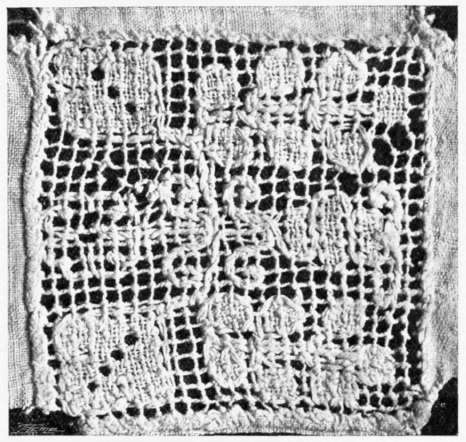
Enlarged Detail of Lacis Work, on a Netted Foundation.
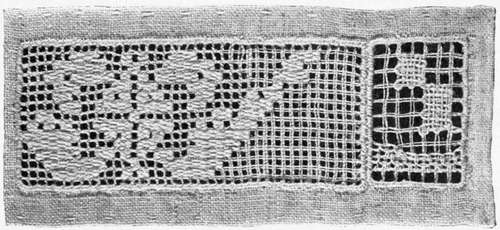
Example of Lacis Work on a Mesh of Linen.
Plate No. 47.
Child's linen cap, with bands of cut and drawn work, and insertion of drawn-thread and needle-point stitches. Sometimes called "Reticella" work.* Italian, seventeenth century [7522 - 1861]. The designs are similar to those found on some English samplers of the seventeenth century. Great care has been bestowed upon the making of the cap, and it is in every way a very dainty little head-dress.
* Bone lace, net work, a net for the head.

Child's Linen Cap. Italian, 17th Century [7522-1861].
Plate No. 48.
Plate No. 49.
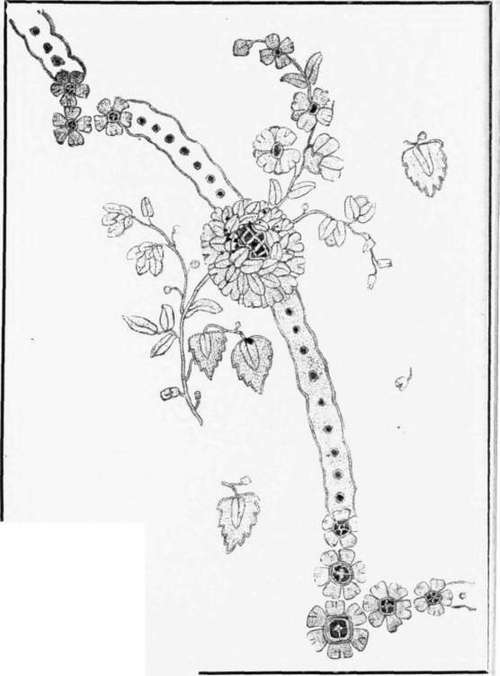
Detail from a Muslin Collar, in Drawn Work and White Embroidery. French, early 19th Century [547 - 1903].
Plate No. 49.
The detail, from a muslin collar on this plate, is slightly smaller than the original in the Victorian and Albert Museum [547 - 1903]. It is early nineteenth century French work. The pattern is in drawn work and white embroidery in cotton threads. The dark parts in the illustration represent the drawn work ; the flowers, small leaves, and centres of large leaves are raised. The rest of the fillings of the large leaves and the banded form is worked in French knots with a fine satin-stitch outline which is also employed for the stems.
Plate No. 50.
The three examples of open-work fillings here given are from a cream-coloured silk apron, eighteenth century, English, in the Victorian and Albert Museum [701 - 1902]. X. This leaf form is filled with berries embroidered in pink silk in satin stitch. These are connected with spiky stems in blue silk; for the outline a green silk cord is used. Y. is an unusual flower form, the treatment of which is very varied, yielding a light, pleasing appearance, in the style of the seventeenth-century examples of English wool work. The lower part of the flower contains a simple diaper, darned ; the leaves are in satin stitch; the upper part of the flower is in green silk and worked in embroidery and stem stitches, with a cord of green silk for the outline. Z. This flower has in the centre berries in plum-coloured silk in satin stitch, with French knots in white silk. The leaf branches, which radiate from the centre, scalloped form, have leaves in blue, white, and plum-coloured silks, embroidered in satin stitch. The stars are in blue silk; the stitch employed is sometimes called Leviathan stitch. The silk is merely crossed on the surface of the material, and is a variety of darning very useful for backgrounds. The outline, as in the other examples on this plate, is a green silk cord, couched.
Plate No. 50.
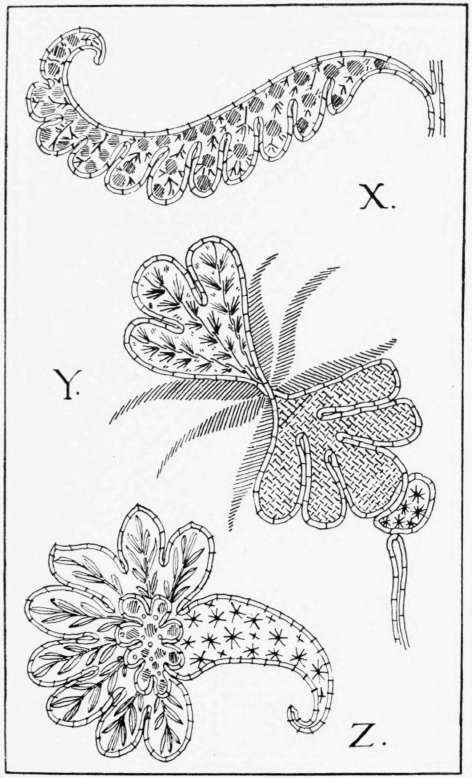
Leaf and Flower Forms from Embroidered Apron. English, early 18th Century [701 - 1902].
Plate No. 51.
The flower given below is an example of English eighteenth-century work. The original is embroidered in satin stitch with orange and red silks on a linen ground. The dark lines indicate the red, following which is the deep orange silk and then a paler shade of orange. It is a spirited and very effective method of working, and may be employed quite successfully for simpler forms than the flower here shown. The groups of stitches must take a definite shape. To follow the outline in crescent fashion is a good plan.
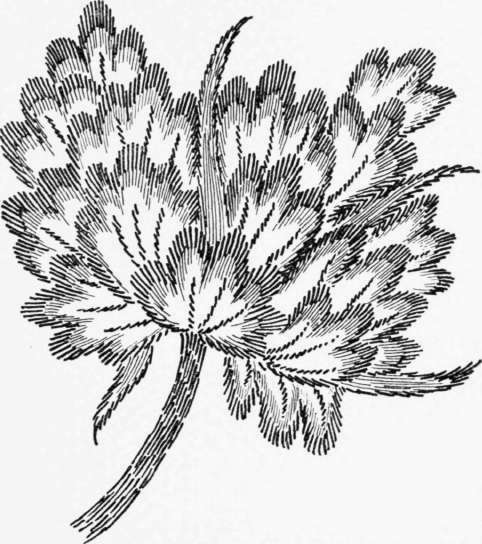
Plate No. 52.
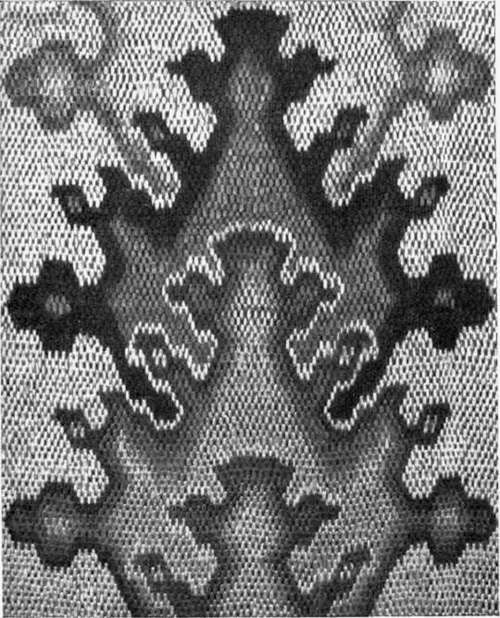
Example of Bargello Work (sometimes called "Florentine ").
17th Century Italian,
Plate No. 52.
Example of "Bargello work" (sometimes called "Florentine"). Italian, seventeenth century. "Bargello work " is the name given a form of tapestry - a solid kind of embroidery with which the ground is entirely covered. Cushion stitch is chiefly employed, and the work is executed on a canvas foundation either in floss silks or in fine tapestry wools, with a blunt-pointed needle. Sometimes coarse canvas is used, but more often small point or single thread canvas. It depends upon the pattern selected to be worked. The original patterns are generally zigzag bands dividing the ground into spaces, which are filled in with geometrical designs, or they may be simply powderings (as in the example on Plate No. 53); these are often outlined in black on a cream or white background. The pattern can be varied by working over one or more threads at a time; the grounding is very often done in this way in order to bring out the main lines of the design.
A simple way of framing the canvas for working, as it must not be stretched tight, is to pin it on to an ordinary drawing-slate frame, which has been padded and bound over and over with calico to make a hold for the pins.
Bargello work is quite straightforward and easy to copy from the old patterns, but the colours are often difficult to match. One of the chief things to remember in working is to pass the thread from one stitch to the next underneath in such a manner that the first stitch made is not pulled crooked or out of place; and great care must be taken in copying to count the threads correctly, as a mistake in one stitch puts the whole pattern wrong.
Continue to:


